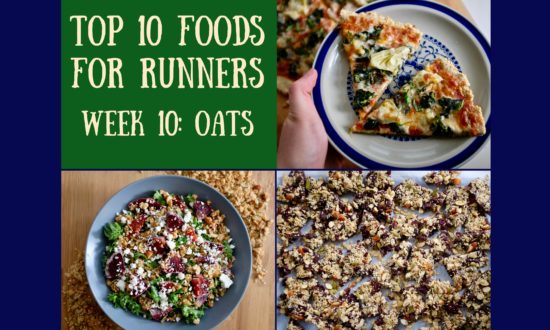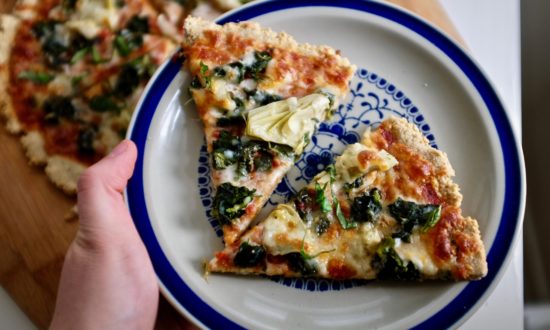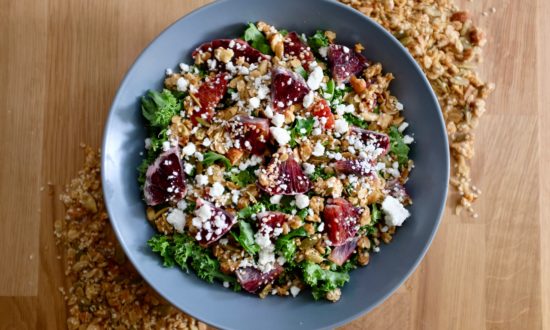Oh hey, week five! When did you get here? Welcome to the halfway point of the Top 10 Foods for Runners series! This week: bear’s favorite pink fish that swims upstream… Salmon!
I’m not much of a fish person, but there was a time when I fell madly in love with salmon. I think I might have been classier back then. This week helped rekindle a bit of our old relationship. Although I will probably never love salmon as much as I once did, I can’t deny that it holds an important place in the runner’s diet.
Salmon is by far the most expensive of the Top 10 Foods for Runners, and it’s nowhere near vegan-friendly. Although including salmon in your diet can help improve your running, it is certainly not an essential part of a runner’s diet. Therefore, salmon can remain an occasional splurge for us non-millionaires and ignored entirely by those who believe fish are friends, not food.
But for those who have enough friends without including the fishy population, salmon has some pretty awesome benefits. In general, fish is an excellent form of protein and full of those omega-3s everyone’s been talking about. But when it comes to nutrients, salmon blows every other fish out of the water (haha).
Super Salmon Benefits
- High-quality protein: A serving of salmon includes about 30 grams of protein! That’s insane!
- Omega-3 fatty acids: One of the best sources you’ll find. These fats are necessary and help to balance the body’s inflammation response. Omega 3 fatty acids also help with joint health, easing joint stiffness over time. And since you’re heart is pretty important when it comes to running (like, your literal heart), omega 3s also reduce the risk of cardiovascular disease.
- Fish oil: People take those gross capsules of fish oil for a reason. Fish oil helps reduce inflammation caused by exercise, aiding in the recovery process and leading to less muscle soreness. Fish oil also helps blood flow, and therefore oxygen delivery, during your runs.
- Vitamin D: Salmon has a good dose of vitamin D, the favorite vitamin of the milk industry. Vitamin D keeps bones strong and healthy. It also supports immune system function.
- B vitamins: The B6 and B12 vitamins found in salmon help the body break down food for energy. B12 also assists in red blood cell production, therefore helping with oxygen transport. This helps runners to optimize their aerobic capacity in their blood to fuel performance.
Tips for Buying Salmon
- Fresh: Fresh salmon is the tastiest, most versatile option. The prices vary depending on what type of salmon you buy. Listed below are some options you may come across.
- Filets and steaks: Smaller cuts of salmon that are better for a quick weeknight meal. Usually, they come with the skin on.
- Sides: serves a crowd, works for a big dinner with lots of guests.
- Wild: Sometimes, labels such as “free-range” on eggs don’t mean all that much. However, when it comes to salmon the difference between “wild” and “farmed” is huge. Wild-caught salmon comes from Pacific waters, has a silky texture, a bright pink hue, superior taste, and less calories than farmed salmon. And of course, it’s more expensive.
- Farmed: Far more abundant than wild salmon (and cheaper), farmed salmon comes from Atlantic salmon stock. It’s lighter in color and due to the way it is farmed, often raises some environmental concerns.
- Frozen: Wild and farmed salmon can be frozen, the fact that it’s frozen doesn’t make much of a different taste or nutrition-wise. Sometimes, frozen might be the only viable option for wild salmon since the fish is not in season all year round. The most important factor to consider is whether you want wild or farmed.
- Canned: Not exactly the most glamorous or tastiest option, but certainly the cheapest! It’s just like canned tuna, but salmon. Good for burgers and salads. The quality can certainly range even in the cans, so check the labeling to see where it came from. And I would avoid the large cans of salmon. They last few times I bought one, it had a spine in it. Which was absolutely traumatizing.
- Smoked: Smoked salmon looks like salmon that has been run over by a fluorescent steamroller. But it’s so tasty! It’s thin and smokey and a bit chewy. Good on crackers and bagels. Plus, because it’s smoked it tends to last a lot longer than the fresh stuff. Again, try to spring for the wild-caught.
How to Cook Salmon
Since smoked salmon and canned salmon don’t need to be cooked, I’ll be discussing different ways to cook your standard salmon filet.
- Removing pinbones: Salmon filets (and sides) often still have these long flexible bones still intact. You don’t have to remove them before cooking, but removing them first results in a nicer-looking fish that’s easier to eat. Experts in all things salmon suggest using pliers (needle-nose pliers, to be exact) to remove the bones. Simply place the salmon skin-side down on a flat surface, run your hand across the surface of the fish until you feel ridges of the bone sticking out. Take your pliers and firmly yank it out, starting from the thickest end. There could be up to 20 of these bones in a whole side.
- Baking: A very easy and hands-off approach to the salmon. It’s also the best way to cook a large amount of salmon at once. Place in an oiled baking dish and season with salt and pepper and whatever glazes or spices you want. Cook at 400 degrees for about 12 minutes.
- Sauteing: Perfect for smaller cuts of salmon and achieves a nice crisp texture. Heat about 1 tbsp of oil or butter in a skillet. Place seasoned filet in the skillet skin-side up and cook without flipping for 6 minutes. Flip and cook an additional 2-4 minutes.
- Poaching: Poaching gives you an evenly cooked fish with no added fat. It’s a good base for sauces and salads. Fill a pan with enough water to cover the filet. Lower in the filet and season with salt, pepper, and whatever other flavorings you wish. Bring water to a simmer and turn off the heat. cover pan and let salmon cook for 20-30 minutes.
- Searing + Roasting: The crispiness of pan-seared and the ease of baking! Preheat oven to 400 degrees. Heat some butter or oil in a cast iron skillet and cook seasoned salmon over high heat to brown (about 3 minutes). Transfer pan to oven and cook about 8-10 minutes.
Recipes
Salmon is great on its own, but if you’re looking for something a little more exciting, here are few recipes you can try!

Teriyaki salmon burger
Ingredients
For the patties
- 8 oz canned salmon
- 2 tbsp green onion, finely chopped
- 1 tsp garlic powder
- 2 tbsp teriyaki sauce
- 1 egg, slightly beaten
- 1/2 tsp salt
- 1/2 tsp pepper
- 1 tsp oil, for frying
For the construction
- 3 tbsp mayo
- 1/2 tsp freshly ground pepper
- 2 pineapple rings
- 2 eggs
- 2 pretzel buns (or other buns)
- 1/2 cup coleslaw mix or lettuce
Instructions
For the patties
-
Drain salmon and transfer to a bowl. Break up large chunks with a fork and add onion, garlic, teriyaki, egg, salt, and pepper. Mix together thoroughly and form two patties.
-
Heat oil in a skillet over medium heat. add patties and cook until seared on both sides. About 3 minutes per side. remove from heat.
For the construction.
-
Mix together mayo and pepper. Set aside.
-
Heat a dry nonstick skillet to medium heat. add pineapple and cook until both sides are slightly charred. Keep skillet heated and cook eggs over easy.
-
Toast the buns and spread black pepper mayo on each one. Top the bottom buns with coleslaw mix/lettuce, salmon patty, pineapple ring, egg, and top slice of the bun. Serve immediately.

Citrus salad with honey butter salmon
Ingredients
For the salmon
- 6-8 oz salmon filet
- 1 tbsp honey
- 2 tbsp butter, divided
- 2 cloves garlic, minced
For the dressing
- 1/2 orange, juiced
- 1/4 tsp orange zest
- 1/2 lime, juice
- 1 tbsp honey
- 2 tbsp avocado oil
For the salad
- 6 cups fresh baby spinach
- 1/4 cup roasted sliced almonds
- 1/3 cup dried cranberries
- 1/2 avocado, diced
- 1/2 orange, peeled and segmented.
Instructions
For the salmon
-
Melt 1 tbsp of butter in a small bowl and add honey and garlic. use a brush to coat salmon filet.
-
Heat the other tablespoon of butter in a skillet over medium heat. Wait until butter has stopped foaming and add salmon. Cook skin side up for 6 minutes, then flip to cook an additional 3-4 minutes. Spoon butter on top of salmon throughout.
-
Remove from heat and set aside. Once slightly cooled, slice in half.
For dressing
-
Whisk together all ingredients except oil. Once combined, continue whisking and pour in oil to emulsify. Set aside.
For the salad.
In a large bowl, combine spinach, almonds, cranberries, orange, and avocado. Pour on the desired amount of dressing and toss to combine. Divide between two plates and top each with salmon filet.

Smoked salmon bagel
Ingredients
- 2 Everything bagels, sliced
- 1/3 cup cream cheese
- 1 green onion, diced
- 1/4 tsp dill
- 1/2 tsp garlic powder
- 2 oz smoked salmon
- 2 soft/hard boiled eggs
- 1/2 avocado, sliced
Instructions
-
Toast bagel slices.
-
Combine cream cheese, onion, dill, and garlic powder. Spread on bagel slices.
-
Peel and slice eggs. Cut salmon into slightly large than bite-sized pieces.
-
Top bagels with avocado, egg slices, and salmon. Enjoy!
Sources
- https://www.runnersworld.com/nutrition/the-best-foods-for-runners/slide/8
- http://tinamuir.com/5-reasons-for-athletes-to-eat-fish-cotter-crunch/
- https://www.theactivetimes.com/salmon-powerful-superfood-every-type-athlete
- https://cooking.nytimes.com/guides/19-how-to-cook-salmon







